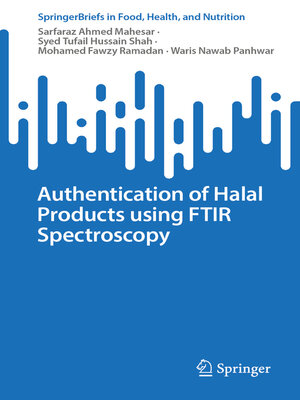Authentication of Halal Products using FTIR Spectroscopy
ebook ∣ SpringerBriefs in Food, Health, and Nutrition
By Sarfaraz Ahmed Mahesar

Sign up to save your library
With an OverDrive account, you can save your favorite libraries for at-a-glance information about availability. Find out more about OverDrive accounts.
Find this title in Libby, the library reading app by OverDrive.



Search for a digital library with this title
Title found at these libraries:
| Library Name | Distance |
|---|---|
| Loading... |
For Muslims, Halal food is crucial, and regulations are in place to protect quality and authenticity, including methods for keeping out forbidden elements. The identification and elimination of non-Halal contents is the basis of the Halal analyses, promoting the development of analytical techniques for Halal product authentications. Gas chromatography-mass spectroscopy (GC-MS), electronic nose (e-nose), Fourier transform infrared (FTIR), high-pressure liquid chromatography (HPLC) and real-time polymerase chain reaction (RT-PCR) are some of the most popular techniques used in Halal food analysis. Due to its satisfactory results, straightforward approach and lack of damaging preparation, FTIR spectroscopy, combined with chemometrics, is an excellent technique for analyzing halal food.
Authentication of Halal Products using FTIR Spectroscopy aims to widen the concept of Halal food by covering FTIR in conjunction with chemometrics for Halal authentication. This combination has never been discussed before in such detail, providing the latest connection between Halal analysis and authentication plus providing comprehensive coverage on FTIR and chemometrics for Halal authentication. Halal authentication of meat, fat, oil, consumer products, and pharmaceuticals are covered plus Halal production, processing, ingredients, storage, logistics methods, and global perspective.







